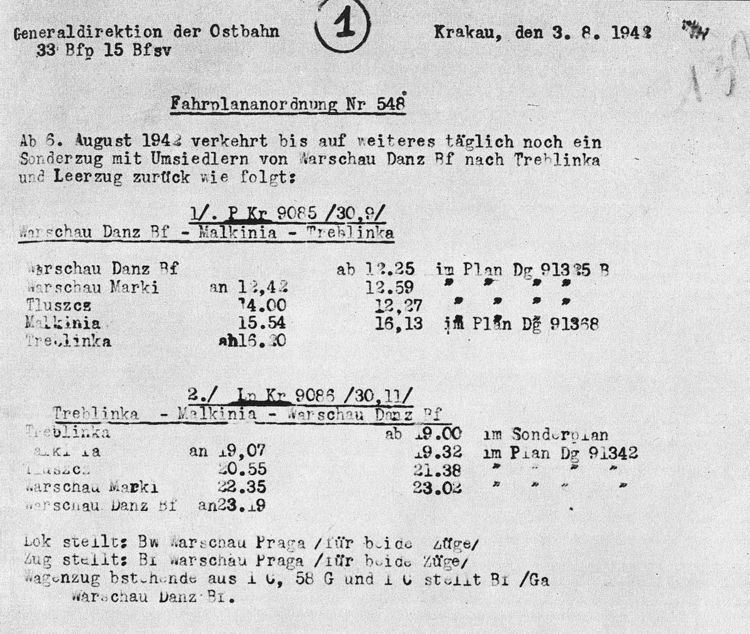 | ||
The Höfle Telegram (or Hoefle Telegram) is a cryptic one page document discovered in 2000 among the declassified World War II archives of the Public Record Office in Kew, England. The document consists of two top secret messages, one to SS Obersturmbannführer Adolf Eichmann in Berlin, and one to SS Obersturmbannführer Franz Heim in German-occupied Kraków (Cracow), sent by SS Sturmbannführer Hermann Höfle on 11 January 1943.
Contents
The Telegram contained the detailed statistics on the 1942 killings of Jews in the extermination camps of Belzec, Sobibor, Treblinka, and Lublin-Majdanek; as compiled by Höfle, most likely from the very precise records shared with the Deutsche Reichsbahn (DRG). Even though the Holocaust train-records were notoriously incomplete as revealed by the Main Commission for the Investigation of German Crimes against the Polish Nation, the quoted numbers shed a new light on the evidential standard of proof for the scope of the crimes committed by the SS. The telegram gave train arrivals in the prior fortnight, as well as cumulative arrivals until 31 December 1942, for the camps of Einsatz Reinhardt (later commonly called Aktion Reinhard), the most deadly phase of the "Final Solution".
Background
The SS paid German Railways the equivalent of a third class ticket for every prisoner transported via Sonderzüge to extermination camps of Operation Reinhard from the Ghettos in Nazi-occupied Europe and the Jewish ghettos in German-occupied Poland. Children under four went free during the Holocaust. The payment was collected from the SS by the German Transport Authority on behalf of the Reichsbahn according to a schedule, at a cost of 4 Pfennig per each track kilometer. The actual waybills did not include the number of prisoners per each Güterwagen boxcar because calculations were predetermined. The standard means of delivery was a 10 metre long cattle freight wagon, although third class passenger carriages were also used with train tickets paid by the Jews themselves, when the SS wanted to keep up the "resettlement to work in the East" myth. The DRB railway manual which was used by the SS for making payments, had a listed carrying capacity of each trainset set up at 50 boxcars, each loaded with 50 prisoners.
In reality, boxcars were crammed with up to 100 persons and routinely loaded from the minimum of 150% to 200% capacity for the same price. Notably, during the mass deportation of Jews from the Warsaw Ghetto to Treblinka in 1942 trains carried up to 7,000 victims each, which means that the SS did not have to forward the payment for the rail transport of more than half of the victims in that time period. According to an expert report established on behalf of the German "Train of Commemoration" project, the receipts taken in by the state-owned Deutsche Reichsbahn for mass deportations in the period between 1938 and 1945 reached a sum of US $664,525,820.34.
Translation
Höfle Telegram is a decoded message, encrypted at source by the German Enigma machine. A missing "5" is added in the table, and is considered to be the correct figure, because only the number 713,555 yields the correct total of 1,274,166, and also, the Korherr Report of 1943 substantiates that the total number of 1,274,166 Jews subjected to "special treatment" (Sonderbehandlung) in General Government is correct to the last incongruous digit. The British decoded version of the Telegram would almost certainly be a transcription error, since British security clearly did not realise what this message was about (see above). It is unlikely that the numerical mistake would have been noticed by them at the time. Admittedly the interception and decoding was not 100% accurate (see reproduction).
For clarity the figures as well as coded letters with their true meaning may be arranged as a table:
Importance of the document
According to the US National Security Agency and the Holocaust historians, "it appears the British analysts who had decrypted the message missed the significance of this particular message at the time. No doubt this happened because the message itself contained only the identifying letters for the extermination camps followed by the numerical totals. The only clue would have been the reference to Operation Reinhard, the meaning of which – the plan to eliminate Polish Jewry that was named after the assassinated SS General Reinhard Heydrich – also probably was unknown at the time to the codebreakers at Bletchley."
The Höfle's radio telegram is one of two evidential proofs making use of the very precise figures, suggesting their common origin; the other one is the Korherr’s report. Both of them detail the numbers involved in the execution of Jews during Einsatz Reinhardt. Apart from quoting identical totals as of 1942, the Telegram also indicates that the camp at Lublin (Majdanek) was part of Odilo Globocnik's Operation Reinhard, a fact that historians previously had not fully realised.
